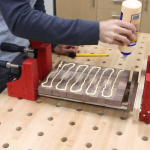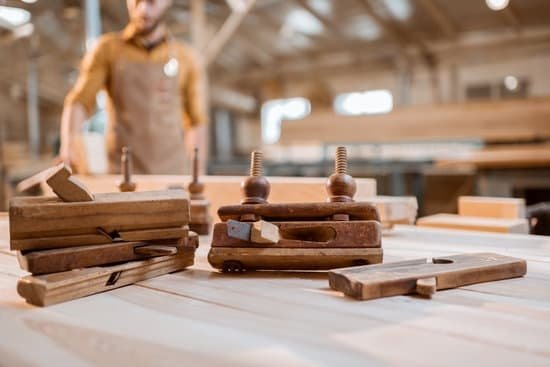Leg vises play a crucial role in the world of woodworking, providing stability, support, and convenience to craftsmen and artisans. These versatile tools are used to hold workpieces firmly in place, allowing for precise and controlled shaping, cutting, and assembly. Whether you’re a seasoned woodworker or just starting out on your woodworking journey, understanding the functionality and importance of leg vises is essential.
In this article, we will delve into the various aspects of leg vises that make them indispensable tools in woodworking. We will explore their historical roots and how they have evolved over time to meet the demands of woodworkers. Additionally, we will examine the anatomy and key components of leg vises, giving you a comprehensive understanding of how they work.
Furthermore, we will provide a step-by-step guide on setting up a leg vise properly to ensure maximum efficiency and usability. You will learn about practical applications where leg vises excel, as well as techniques and tips for mastering their use to optimize your woodworking projects.
Lastly, we will discuss maintenance and preservation practices that will help prolong the lifespan of your leg vises while ensuring their continued effectiveness.
By the end of this article, you will gain a newfound appreciation for the power and versatility of leg vises – indispensable tools that elevate woodworking projects from ordinary to extraordinary. So join us as we uncover the world of leg vises in woodworking and embrace their significance in craftmanship.
A Historical Overview
Woodworking has a rich history that can be traced back thousands of years, and leg vises have played a significant role in the evolution of woodworking tools. The use of leg vises can be seen across various cultures and time periods, showcasing its importance and functionality in the craft.
In ancient civilizations such as Egypt and Mesopotamia, early forms of leg vises were used to hold pieces of wood securely during woodworking tasks. These early versions consisted of a wooden screw mechanism attached to a fixed base, allowing woodworkers to clamp their workpieces tightly in place. Over time, the design and functionality of the leg vise continued to evolve.
During the Middle Ages and Renaissance period in Europe, leg vises became more sophisticated. They were commonly made with metal components for added strength and durability. The wooden screw was replaced with an iron or steel screw threaded through a cast iron nut, offering smoother operation and increased grip on the workpiece.
As industrialization took hold in the 18th and 19th centuries, leg vises underwent further improvements. The introduction of mass production techniques allowed for more affordable and accessible leg vises. This led to widespread adoption among woodworkers and craftsmen around the world.
Today, leg vises continue to be an essential tool in woodworking. While their design has remained relatively unchanged over time, modern variations may incorporate ergonomic features or different materials for aesthetic appeal. Regardless of these slight modifications, leg vises remain indispensable in providing stability and support during woodworking projects.
Components of a Leg Vise
Leg vises are an essential tool in woodworking, providing stability and support for various tasks. Understanding the anatomy and key parts of a leg vise is crucial for utilizing it effectively. This section will explore the components of a leg vise, giving woodworkers a deeper understanding of how this tool functions.
The main components of a leg vise include the wooden chop or jaw, the screw mechanism, the guide rods, and the bench leg. The wooden chop or jaw is usually made from hardwood and serves as the clamping surface. It is fixed to the front edge of the workbench and provides a sturdy anchor for holding the workpiece in place.
The screw mechanism is at the heart of a leg vise. It consists of a long threaded rod and a handle that rotates to move the screw in or out. When turned clockwise, it tightens the wooden chop against the workpiece, securing it firmly. The guide rods run parallel to each other on either side of the screw mechanism, ensuring smooth movement and preventing any wobbling.
| Component | Description |
|---|---|
| Wooden Chop/Jaw | The clamping surface made from hardwood that holds the workpiece |
| Screw Mechanism | A long threaded rod with a rotating handle used to tighten or loosen the wooden chop |
| Guide Rods | Parallel rods that provide stability and prevent wobbling during clamping |
| Bench Leg | The vertical support structure that holds and stabilizes all other components. |
The bench leg acts as the vertical support structure for all the other components. It provides stability and ensures that the leg vise remains securely attached to the workbench. The combination of these components allows woodworkers to secure their workpieces firmly, enabling them to carry out a wide range of woodworking tasks with precision and ease.
By understanding the anatomy of a leg vise, woodworkers can make informed decisions about purchasing or building their own leg vises. Additionally, knowing how each component functions will enable them to troubleshoot any issues that may arise during use. With this knowledge, woodworkers can confidently incorporate leg vises into their woodworking projects and enhance the quality and efficiency of their work.
Setting Up a Leg Vise
A leg vise is an essential tool in woodworking that provides stability and support for various projects. Setting up a leg vise properly is crucial to ensure its effectiveness and longevity. In this section, we will provide a step-by-step guide on the proper installation and adjustment of a leg vise.
- Determine the location: The first step in setting up a leg vise is choosing the right location on your workbench. Ideally, the leg vise should be mounted towards one end of the bench, allowing for ample space to maneuver around it. Consider the project size and dimensions when deciding on the placement of your leg vise.
- Mark the mounting holes: Once you have determined the location of your leg vise, use a pencil or marker to mark where you will be drilling mounting holes on both the workbench top and leg assembly. Ensure that the marking is accurate and aligns with the center line of the wood pieces.
- Drill pilot holes: With your markings in place, use an appropriate-sized drill bit to create pilot holes for mounting screws. These pilot holes will prevent any splitting or cracking when securing your leg vise onto the workbench top and leg assembly.
- Attach wooden blocks: To reinforce stability and prevent potential damage to your workbench, attach wooden blocks underneath where you marked for mounting holes. This extra layer of support will distribute weight evenly across a larger surface area.
- Secure mounting plates: Install mounting plates onto both sides of the workbench top using appropriate screws or bolts based on their design specifications. Make sure they are level and securely fastened.
- Attach the guide bar: Slide tthe guide bar into position between your mounting plates so that it fits snugly into place but still allows smooth movement along its length.
- 7.Adjustment for optimal performance: Once the leg vise is installed, it’s important to make adjustments for optimal performance. This includes checking and adjusting the alignment of the vise jaw with the guide bar to ensure even pressure distribution during clamping. Additionally, lubricating any moving parts with a suitable woodworking lubricant will help enhance smooth operation.
Setting up a leg vise may require some time and effort initially, but it is an important step in optimizing your woodworking projects. By following this step-by-step guide, you can ensure that your leg vise is securely installed and adjusted for stability and precision.
Practical Applications
Leg vises are versatile tools that can be used for a wide range of tasks in woodworking. Whether you are shaping, cutting, or assembling wood, a leg vise can provide the necessary support and stability to enhance your woodworking projects. In this section, we will explore some practical applications of leg vises and how they can be used effectively in various woodworking tasks.
Holding Workpieces Securely
One of the primary functions of a leg vise is to hold workpieces securely in place while working on them. The strong clamping force provided by the vise ensures that the workpiece remains stable and immovable during cutting, shaping, or carving processes. This allows woodworkers to have better control over their tools and achieve more accurate results.
Hand Planing
Leg vises are particularly useful when it comes to hand planing wood. By securing the workpiece vertically between the vise jaws, woodworkers can comfortably apply even pressure along the length of the piece with their hand plane. This setup provides stability and prevents any unwanted movement, resulting in smoother and more precise planing.
Joinery Work
When it comes to joinery work such as mortise and tenon joints or dovetails, leg vises prove to be invaluable tools. They allow woodworkers to securely hold both the stock being worked on and any additional pieces required for accurate measurements or referencing purposes. This ensures that joinery cuts are made with precision and produces tight-fitting joints.
Assembly Work
Leg vises are also widely used for assembling different wooden components together. By clamping two or more pieces in place using a leg vise, woodworkers can ensure that they fit together properly before permanently attaching them with screws, nails, or other fasteners. The stability provided by the vise eliminates the risk of misalignment and allows for smoother assembly processes.
Overall, leg vises are versatile tools that can enhance a wide range of woodworking tasks. From holding workpieces securely to facilitating hand planing, joinery work, and assembly processes, these tools offer stability and control to woodworkers. By incorporating a leg vise into your woodworking workshop, you can elevate the quality and precision of your projects.
Techniques and Tips
Leg vises are versatile and powerful tools in woodworking that can significantly enhance the efficiency and precision of various woodworking projects. Mastering the art of utilizing leg vises requires a combination of technique and knowledge, along with some useful tips to optimize their functionality. Whether you are a beginner or an experienced woodworker, here are some techniques and tips to help you make the most out of your leg vise:
- Proper Clamping Techniques: One important technique is to ensure proper clamping of the workpiece in the leg vise. Start by marking the position on the workpiece where you want to clamp it and then align it with the vise jaw. Place wooden blocks or padding on both sides of the workpiece before clamping it down firmly. This helps prevent damage to your project while providing a secure grip.
- Utilizing Supports and Bench Dogs: Leg vises can be used in conjunction with bench dogs or supports to provide additional stability during woodworking tasks. Bench dogs are cylindrical pegs that fit into corresponding holes in your workbench, allowing you to support longer pieces of wood horizontally. This ensures better control over your workpiece and reduces the risk of accidents.
- Experimenting with Different Work Positions: It is important to find a comfortable and efficient work position when using a leg vise. Consider experimenting with different heights and angles until you find one that provides optimal control and visibility over your project. This will vary depending on personal preference, as well as the specific task at hand.
- Preventing Damage: To prevent damage to both your workpiece and the vise jaws, consider using protective materials such as leather or felt pads between them. This acts as a cushion and minimizes any potential marks or dents caused by clamping pressure.
- 5.Working within Weight Limits: Leg vises have weight limits which dictate how much force they can safely handle without compromising their integrity or causing damage. Make sure to check the weight limit specified by the manufacturer and avoid exceeding it. If you need to exert more force, consider using additional clamps or a different type of vise.
By employing these techniques and tips, woodworkers can master the art of utilizing leg vises to optimize their woodworking projects. Remember to always prioritize safety, proper technique, and regular maintenance of your leg vise to ensure its longevity and efficiency. With practice, you will develop your own unique approach, unlocking the full potential of this indispensable tool in the world of woodworking.
Maintaining and Preserving Leg Vises
Leg vises are essential tools in woodworking, and like any other tool, they require proper maintenance and care to ensure their longevity and efficiency. In this section, we will explore best practices for maintaining and preserving leg vises, so you can continue to rely on these indispensable tools for your woodworking projects.
Cleaning and Lubricating
One of the most important aspects of maintaining a leg vise is keeping it clean and properly lubricated. Over time, sawdust, dirt, and debris can accumulate in the screw mechanism, causing it to become stuck or difficult to operate. To prevent this from happening, it is recommended to regularly clean the vise’s components using a brush or compressed air to remove any built-up residue.
Once the leg vise is clean, applying a lubricant specifically designed for woodworking tools is essential. This will help reduce friction between moving parts and ensure smooth operation. Be sure to apply lubricant to all areas that require movement – including the screw mechanism, guide rods, pivot points, and any other joints.
Inspecting for Wear and Damage
Regular inspections are crucial for identifying any wear or damage that may affect the performance of the leg vise. Pay close attention to the condition of the screw threads, handle grip, jaw faces (including any protective coverings), and any movable parts. Any signs of wear or damage should be addressed promptly.
If you notice a loose or wobbly handle grip or misalignment between jaws when closing the vise, tightening or adjusting these components may be necessary. It’s also important to check for cracks or dents in the jaw faces as they may affect clamping stability.
Storage and Protection
When not in use, it’s important to store your leg vise properly to protect it from environmental factors that could cause rust or damage. Ensure that the surfaces are dry and clean before storing, and consider covering the vise with a cloth or tarp to prevent dust or other debris from accumulating.
If your workshop is prone to high humidity levels, you may want to use a rust-preventive spray on the metal parts of the leg vise to further protect against corrosion. Additionally, it’s beneficial to store the vise in a location where it won’t be at risk of being knocked over or damaged by falling objects.
By following these best practices for maintaining and preserving leg vises, you can ensure that they remain in optimal condition for years to come. Regular cleaning, lubricating, inspecting for wear and damage, as well as proper storage and protection will maximize the longevity and efficiency of your leg vise, allowing you to continue enjoying its valuable contribution to your woodworking projects.
Comparing Different Types of Leg Vises
There are various types of leg vises available in the world of woodworking, each with its own set of pros and cons. Understanding the differences between traditional and modern variations can help woodworkers choose the right type for their specific needs.
Traditional leg vises are typically made from hardwood and have been used for centuries. They consist of a wooden jaw that is attached to a bench leg using wooden screws or wedges. One advantage of traditional leg vises is their durability and strength, as they are designed to withstand heavy-duty tasks. Additionally, the wooden components of these vises can be easily repaired or replaced if necessary.
On the other hand, modern variations of leg vises often incorporate metal components for added strength and stability. These vises typically use a steel threaded rod instead of wooden screws or wedges for easier adjusting. One advantage of modern leg vises is their enhanced precision and versatility. The use of metal allows for smoother operation and more accurate clamping, making them suitable for intricate woodworking projects.
However, there are some drawbacks to consider when comparing traditional and modern leg vises. Traditional models may require more time and effort to properly install and adjust due to their wooden components. On the other hand, some woodworkers prefer the tactile feel and aesthetic appeal of working with traditional vises. Modern variations, while easier to operate and adjust, may not offer the same rustic charm or authenticity that comes with using traditional tools.
Conclusion
In conclusion, leg vises are undeniably indispensable tools in the world of woodworking. Their functionality and importance cannot be overstated, as they provide woodworkers with a reliable and versatile means of clamping and holding workpieces securely in place. From their historical roots to their modern variations, leg vises have evolved over time to meet the needs of woodworkers of all skill levels.
Understanding the anatomy and key components of a leg vise is crucial for setting it up correctly. Following a step-by-step installation guide ensures that the vise is properly adjusted and optimized for woodworking projects.
Once set up, woodworkers can explore the versatility and range of tasks that can be accomplished using a leg vise. Whether it’s holding pieces together during joinery or securing large workpieces for planing or sanding, a well-functioning leg vise is an invaluable asset.
Mastering the art of utilizing leg vises also involves learning various techniques and tips. Woodworkers must familiarize themselves with different clamping positions, angles, and pressures to get the most out of their leg vise. Additionally, proper maintenance and preservation practices are essential for ensuring the longevity and efficiency of these tools. Regular cleaning, lubrication, and inspection will help prevent rusting and keep the vise in optimal condition.
Lastly, it is worth noting that there are different types of leg vises available in the market today. Traditional designs offer a classic aesthetic appeal while modern variations may come with added features for convenience or improved performance. Evaluating the pros and cons of each type allows woodworkers to choose the best option based on their specific needs and preferences.
Frequently Asked Questions
What is a leg vise used for?
A leg vise is a type of vise that is commonly used in woodworking and other crafts. It typically consists of a long metal screw attached vertically to a sturdy bench or work surface, with a jaw at the top that can be tightened or released by turning the screw.
The primary purpose of a leg vise is to firmly hold pieces of wood or other materials in place during various woodworking tasks, such as sawing, planing, or chiseling. This type of vise is particularly useful when working on larger projects or when more clamping force is required.
What is a vice used for in wood?
In woodworking, a vice, also known as a bench vice or woodworking vice, serves as an essential tool for securely holding wooden pieces during various tasks. Unlike leg vises which are mounted on benches or work surfaces, this type of vice is typically mounted directly onto the benchtop itself.
Woodworking vises usually have two jaws – one jaw with toothed faces that grip the wood firmly, and another jaw that can be moved closer to or farther from the fixed jaw using either a threaded rod or quick-release mechanism. These features allow woodworkers to hold their workpieces securely while they perform tasks like sawing, drilling, carving, sanding, and more.
What is the best position for a woodworking vise?
The best position for a woodworking vice depends on several factors including personal preference and the specific task at hand. However, there are generally two common positions that woodworkers tend to use: front-mounted and side-mounted vises.

Hi everyone! I’m a woodworker and blogger, and this is my woodworking blog. In my blog, I share tips and tricks for woodworkers of all skill levels, as well as project ideas that you can try yourself.





